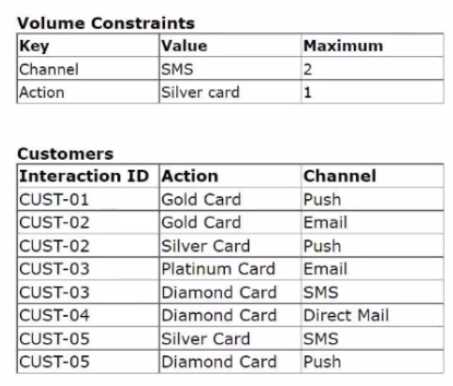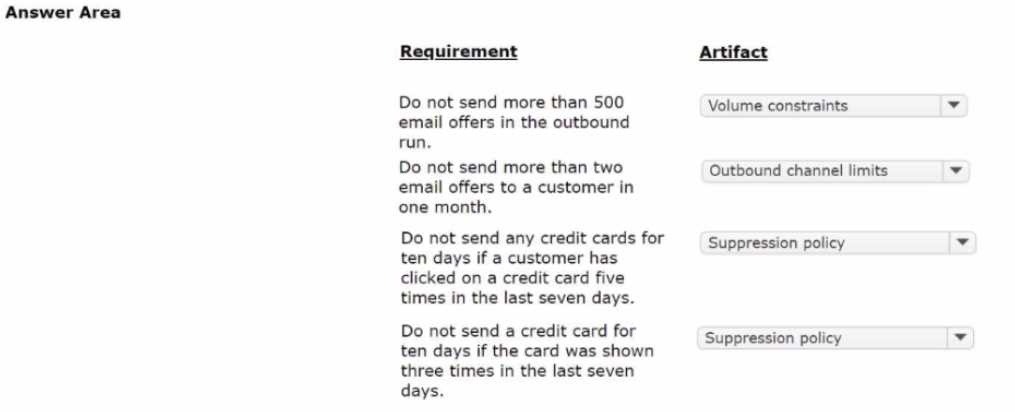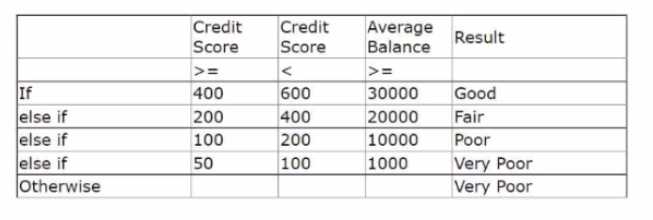Pegasystems pegacpdc88v1 practice test
Certified Pega Decisioning Consultant
Question 1
A volume constraint uses the Return any action that does not exceed
constraint mode. The following tables show the configuration of the volume constraints and the list
of customers in the outbound segment:
The outbound run selects customers in the following order to apply the volume constraints: CUST-01,
CUST-02, CUST-03, and CUST-05.
Based on the configuration of the volume constraints for each channel, which offer does CUST-05
receive?
- A. None
- B. Silver card and Diamond card
- C. Diamond card
- D. Silver card
Answer:
C
Explanation:
CUST-05 receives the Diamond card offer because it is the only action that does not exceed the
volume constraint for the email channel. The Silver card offer has already reached its limit of 2 emails
per day, so it is not eligible for CUST-05. The volume constraint mode Return any action that does not
exceed means that any action that meets the eligibility and suitability criteria and does not violate
the volume constraint will be returned, even if there are other actions with higher priority or
propensity. Verified Reference:
Certified Pega Decisioning Consultant | Pega Academy
, Volume
constraints
Question 2
A financial institution has created a new policy that states the company will not send more than 500
emails per day. Which option allows you to implement the requirement?
- A. Suppression rules
- B. Outbound channel limits
- C. Applicability rules
- D. Volume constraints
Answer:
D
Explanation:
Volume constraints allow you to limit the number of times an action is presented to customers across
one or more channels. You can use volume constraints to implement a policy that restricts the
number of emails sent per day. Outbound channel limits are used to limit the number of customers
contacted per channel per run, not per day. Suppression rules are used to exclude customers from
receiving an action based on certain conditions, such as opt-out preferences or recent purchases.
Applicability rules are used to determine whether an action is relevant for a customer based on their
profile or context, not based on the number of times the action is presented. Verified
Reference:
Certified Pega Decisioning Consultant | Pega Academy
, Volume constraints
Question 3
Which of the following reasons explains why a customer might receive an action that they already
accepted?
- A. The action suitability conditions are not defined.
- B. The volume constraint is not set to exclude previously accepted offers.
- C. The suppression rules are not defined to exclude previously accepted actions.
- D. The actions are filtered based on eligibility.
Answer:
B
Explanation:
A customer might receive an action that they already accepted if the volume constraint for that
action is not configured to exclude previously accepted offers. This option can be enabled by
selecting the Exclude previously accepted actions checkbox in the volume constraint configuration.
The action suitability conditions are used to determine whether an action is suitable for a customer
based on their propensity, priority, or other criteria, not based on their previous responses. The
suppression rules are used to exclude customers from receiving an action based on certain
conditions, such as opt-out preferences or recent purchases, not based on their previous responses.
The actions are filtered based on eligibility before applying the volume constraints, so this option
does not explain why a customer might receive an action that they already accepted. Verified
Reference:
Certified Pega Decisioning Consultant | Pega Academy
, Volume constraints
Question 4
HOTSPOT
U+ Bank's marketing department currently promotes various credit card offers by sending emails to
qualified customers. The bank wants to limit the number of offers that customers can receive over a
given period of time.
In the Answer Area, select the correct artifact you use to implement each requirement.
Answer:
Explanation:
Question 5
An outbound run identifies 150 Standard card offers, 75 on email, and 75 on the SMS channel. If the
following volume constraint is applied, how many actions are delivered by the outbound run?
- A. 150
- B. 75 emails 25 SMSes
- C. 75 SMSes and 25 emails
- D. 100
Answer:
B
Explanation:
The outbound run delivers 75 emails and 25 SMSes for the Standard card offer because the volume
constraint is set to limit the number of actions per channel per day. The email channel has a limit of
75 actions per day, so all 75 email offers are delivered. The SMS channel has a limit of 25 actions per
day, so only 25 SMS offers are delivered. The remaining 50 SMS offers are not delivered because they
exceed the volume constraint.
Question 6
U+ Bank's marketing department currently promotes various home loan offers to qualified
customers. Now, the bank does not want to show offers on a customer's account page if the
customer has already received three home loan offers in the last two weeks.
What do you need to define to implement the business requirement?
- A. Applicability rules
- B. Customer contact limits
- C. Suppression policy
- D. Volume constraints
Answer:
C
Explanation:
A suppression policy allows you to define conditions that prevent customers from receiving an action
or a group of actions. You can use a suppression policy to implement the requirement that customers
do not see home loan offers on their account page if they have already received three home loan
offers in the last two weeks. You can configure the suppression policy to suppress the home loan
group based on the number of times the customer received any action from that group in the past 14
days. Applicability rules are used to determine whether an action is relevant for a customer based on
their profile or context, not based on the number of times they received an action. Customer contact
limits are used to limit the number of times a customer can be contacted per channel per time
period, not based on the number of times they received an action. Volume constraints are used to
limit the number of times an action is presented to customers across one or more channels, not
based on the number of times they received an action. Verified Reference: [Certified Pega
Decisioning Consultant | Pega Academy], Suppression policies
Question 7
The U+ Bank marketing department currently promotes various home loan offers to qualified
customers. Now, the bank does not want customers to receive more than four promotional emails
per quarter, regardless of past responses to that action by the customer.
Which option allows you to implement the business requirement?
- A. Volume constraints
- B. Outbound channel limits
- C. Suppression policies
- D. Suitability rules
Answer:
A
Explanation:
Volume constraints allow you to limit the number of times an action is presented to customers across
one or more channels. You can use volume constraints to implement the requirement that customers
do not receive more than four promotional emails per quarter, regardless of past responses to that
action by the customer. You can configure the volume constraint to limit the number of actions per
channel per quarter and select the option to ignore previous responses. Outbound channel limits are
used to limit the number of customers contacted per channel per run, not per quarter. Suppression
policies are used to exclude customers from receiving an action based on certain conditions, such as
opt-out preferences or recent purchases, not based on the number of times the action is presented.
Suitability rules are used to determine whether an action is suitable for a customer based on their
propensity, priority, or other criteria, not based on the number of times the action is presented.
Question 8
U+ Bank has recently defined two contact policies:
1. Suppress a group of credit card offers for 30 days if any credit card offer is rejected three times in
any channel in the past 15 days.
2. Suppress the Reward card offer, part of the credit card group, for 7 days if it is rejected twice in
any channel in the last 7 days. Paul, an existing U+ Bank customer, no longer sees the Reward card
offer. What is the reason that Paul cannot see the offer?
- A. Paul rejected the Reward card offer once in contact center.
- B. Paul rejected the Reward card offer once on the web channel.
- C. Paul rejected other credit card offers twice on the web channel and once in contact center.
- D. Paul rejected other credit card offers once on the web channel and once in the contact center.
Answer:
C
Explanation:
Paul cannot see the Reward card offer because he rejected other credit card offers twice on the web
channel and once in contact center in the past 15 days. This triggers the first contact policy that
suppresses a group of credit card offers for 30 days if any credit card offer is rejected three times in
any channel in the past 15 days. The Reward card offer is part of the credit card group, so it is
suppressed for Paul for 30 days. The second contact policy that suppresses the Reward card offer for
7 days if it is rejected twice in any channel in the last 7 days does not apply because Paul did not
reject the Reward card offer twice in any channel in the last 7 days. Verified Reference: [Certified
Pega Decisioning Consultant | Pega Academy], Suppression policies system Following is the
description of the image that was sent with question no:5:
This is a screenshot of a table with four columns and two rows.
The table has a header row with white text on a blue background.
The header row reads “Constraint name”, “Constraint mode”, “Constraint value”, and “Channel”.
The second row has black text on a white background.
The second row reads “Standard card”, “Return any action that does not exceed”, “100”, and “Daily”.
The table has a gray border and a light blue background.
Question 9
A bank has been running traditional marketing campaigns for many years. One such campaign sends
an offer email to qualified customers on day one. On day five, the bank presents a similar offer if the
first email is ignored.
If you re-implement this requirement by using the always-on outbound customer engagement
paradigm, how do you approach this scenario?
- A. Create two segments to identify the target audience for each of the two offer emails: day one, and day five. Set up two schedules per day for the two segments.
- B. Create an action with a flow that contains two Send Email shapes, one for each email. Set appropriate wait times between the shapes.
- C. Configure the primary schedule to run daily and let the artificial intelligence (AI) choose the best action based on engagement policies.
- D. Configure a primary schedule for the original offer email and setup an ad-hoc schedule to send the second email.
Answer:
C
Explanation:
The always-on outbound customer engagement paradigm relies on AI to select the best action for
each customer at any given time, based on their profile, context, and behavior. You do not need to
create separate segments or schedules for different offers or timings. You can configure the primary
schedule to run daily and let the AI choose the best action based on engagement policies, such as
contact policies, eligibility rules, suitability rules, and arbitration. The AI will also learn from the
customer responses and optimize the action selection over time.
Question 10
l)+ Bank uses Pega Customer Decision Hub™ to approve credit card limit changes requested by
customers automatically. A scorecard model determines the customer credit score. The automatic
approval of credit card limits are processed based on the following criteria set by the bank.
The bank wants to change the threshold value for the USD2000 credit limit from <175 to <200. How
do you implement this change?
- A. Change the cutoff value in the Results tab of the scorecard decision component.
- B. Change in the strategy the condition from .pxSegment <=175 to .pxSegment <=200.
- C. Map the score value in the decision strategy to <=200.
- D. Change the cutoff value in the Results tab of the scorecard model.
Answer:
D
Explanation:
The scorecard model determines the customer credit score based on various factors, such as income,
expenses, assets, liabilities, etc. The scorecard model has a Results tab where you can define the
cutoff values for different segments based on the credit score. To change the threshold value for the
USD2000 credit limit from <175 to <200, you need to change the cutoff value in the Results tab of the
scorecard model. Changing the cutoff value in the scorecard decision component, changing the
condition in the strategy, or mapping the score value in the decision strategy will not affect the credit
score calculation or segmentation.
Question 11
What does a dotted line from a "Group By" component to a "Filter" component mean?
- A. There is a one-to-one relationship between the "Group By" and the "Filter" components.
- B. To evaluate the "Group By" component, the "Filter" component is evaluated first.
- C. A property from the "Group By" is referenced by the “Filter" component.
- D. Information from the "Group By" is copied over to the "Filter" component.
Answer:
C
Explanation:
A dotted line from a “Group By” component to a “Filter” component means that a property from the
“Group By” is referenced by the “Filter” component. For example, if you group customers by age and
then filter them by average spending, you need to reference a property from the “Group By”
component, such as .pxSegment, in the “Filter” component. A dotted line does not indicate a one-to-
one relationship, an evaluation order, or a copying of information between components
Question 12
In a decision strategy, to use a customer property in an expression, you
- A. define the property as a strategy property
- B. define Customer page in Pages & Classes
- C. use the property as defined without any prefix
- D. prefix the property with the keyword Customer
Answer:
B
Explanation:
In a decision strategy, to use a customer property in an expression, you need to define Customer
page in Pages & Classes and specify its class as Data-Customer. This allows you to access customer
properties by using dot notation, such as Customer.Age or Customer.Gender. You do not need to
define the property as a strategy property, use it without any prefix, or prefix it with the keyword
Customer. Verified Reference: [Certified Pega Decisioning Consultant | Pega Academy], Decision
strategies
Question 13
DRAG DROP
You are a deaccessioning architect on a next-best-action project and are responsible for designing
and implementing decision strategies. Select each component on the left and drag it to the correct
requirement on the right.
Answer:
Explanation:
Question 14

U+ Bank wants to offer credit cards only to low-risk customers. The customers are divided into
various risk segments from Good to Very Poor. The risk segmentation rules that the business
provides use the Average Balance and the customer Credit Score.
As a decisioning architect, you decide to use a decision table and a decision strategy to accomplish
this requirement in Pega Customer Decision Hub™.
Using the decision table, which label is returned for a customer with a credit score of 240 and an
average balance 35000?
- A. Very Poor
- B. Good
- C. Fair
- D. Poor
Answer:
D
Explanation:
Using the decision table, you can find the label for a customer with a credit score of 240 and an
average balance of 35000 by following these steps:
Start from the top row and check if the customer’s credit score is less than 150. If yes, then the label
is Very Poor. If no, then move to the next row.
Check if the customer’s credit score is less than 175 and their average balance is less than 25000. If
yes, then the label is Poor. If no, then move to the next row.
Check if the customer’s credit score is less than 200 and their average balance is less than 50000. If
yes, then the label is Fair. If no, then move to the next row.
Check if the customer’s credit score is less than 250 and their average balance is less than 75000. If
yes, then the label is Good. If no, then move to the last row.
The last row applies to all other cases that do not match any of the previous conditions. The label for
this row is Very Poor.
In this case, the customer’s credit score is not less than 150, so the first row does not apply. The
customer’s credit score is less than 175, but their average balance is not less than 25000, so the
second row does not apply either. The customer’s credit score is not less than 200, so the third row
does not apply. The customer’s credit score is less than 250 and their average balance is less than
75000, so the fourth row applies. Therefore, the label for this customer is Poor.
Question 15
HOTSPOT
U+ Bank, a retail bank, presents offers on its website by using Pega Customer Decision Hub™. The
bank wants to leverage Customer Decision Hub capabilities to present relevant offers to qualified
customers. As a decisioning consultant, you are responsible for configuring the business
requirements with the Next-Best-Action Designer, which involves several tasks. To accomplish these
tasks, you might have to use auto-generated decision strategies, create new decision strategies, or
edit existing strategies.
In the Answer Area, select the correct execution for each Task.
Answer:
Explanation: